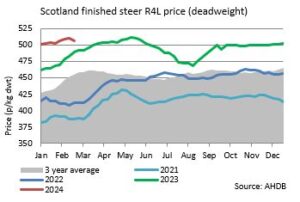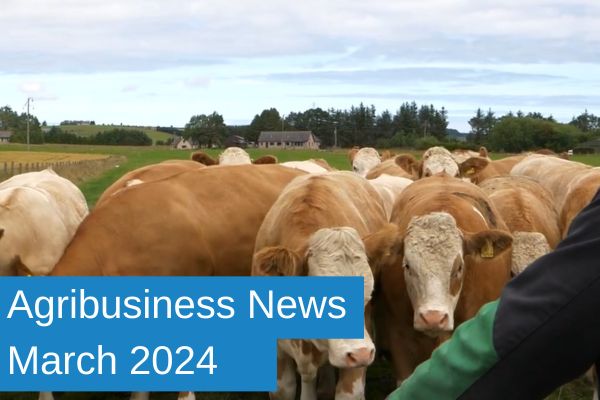Agribusiness News March 2024 – Beef
1 March 2024Brakes on
Prime cattle trade has remained firm since Christmas, largely due to tightening supplies of cattle. The volume of cows culled inevitably means there are not the calves available, coupled with a trend to finish cattle quicker and at a younger age means that there are and will be fewer cattle in the system now and going forward. In theory, availability for slaughter in Scotland should be seasonally high in early 2024 as the spring calf crop from 2022 reaches peak slaughter age, however reports suggest going forward that processors could soon be competing for cattle like never before.
In the meantime, it appears processors are mindful of increasing prices, with prime cattle prices remaining steady in February. For week ending February 17th R4L prices were sitting at 509p/kg dwt (+ 5.7% on the year). Although there is much talk about the lack of cattle, the demand for beef is also very strong. Recent reports from AHDB show good demand for red meat.
Markets selling live finished cattle have seen increased demand ringside and, in some areas, have revitalised how cattle are sold, highlighting how important the auction market system is. Several Scottish markets have reported, prime sales are attracting an increasing number of buyers from south of the border due to the shortage of finished cattle.
Buoyant Store Trade
There has been no let-up in store cattle trade, with the strong demand continuing. Heavy forward stores are still very much in demand due to their short turnaround time on the finishing farms. However, there are less of these sorts available, so finishers are now buying lighter stores to maintain numbers and refill sheds as reports suggest that stores coming forward are tightening in numbers. A fall in barley price has also encouraged people to buy store cattle. Going forward, it is unlikely that prices will fall back when finishers need to keep their numbers up.

Straw Scarcity
Although silage stocks for most are plentiful, the wet summer of 2023 is now affecting straw availability, with scarcity increasing prices significantly. It looks as though straw prices are now experiencing input inflation. Thankfully for businesses, requiring large amounts of straw did not come in 2022 when other inputs were inflating greatly. Prices are increasing quickly and if continue will result in the highest bedding costs realised for several years.
Breeding Stock
There is real optimism and keenness for breeding stock, with the recent two weeks of bull sales at Stirling, seeing commercial buyers keen to invest in top quality bulls which lead to significant increases in breed sale averages and clearance rates. Commercial buyers are now paying five figure sums for bulls.
The decline in suckler cow numbers, didn’t affect trade for maternal breeds which were in demand with the Simmental breed achieving the sale’s top price and a sale average of £7498, while Luings achieved a 100% clearance averaging £10,458.

Sign up to the FAS newsletter
Receive updates on news, events and publications from Scotland’s Farm Advisory Service

